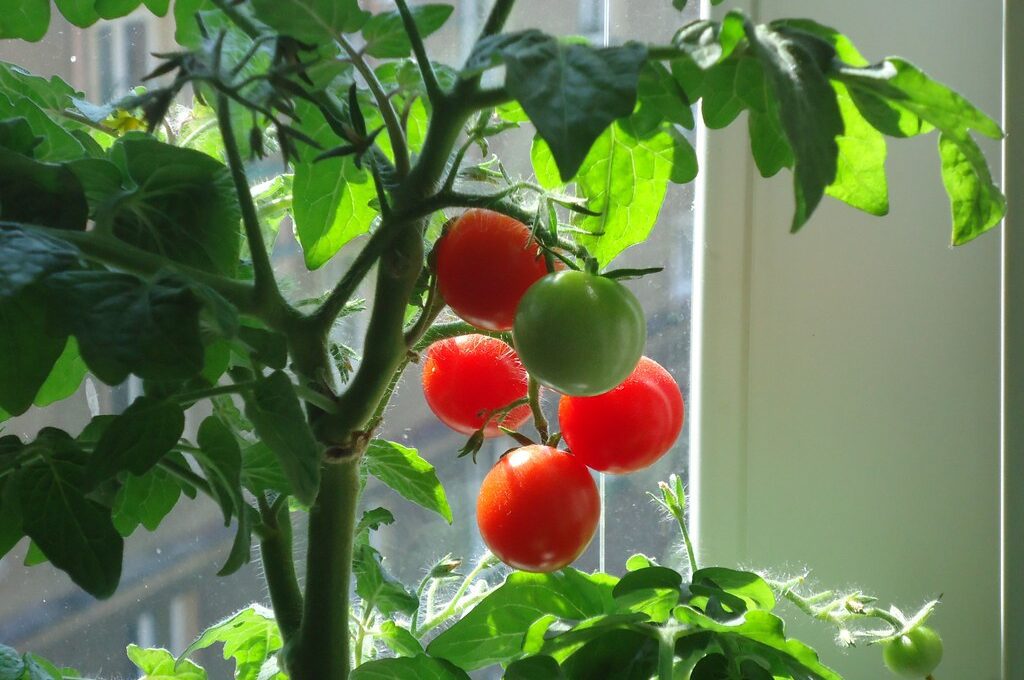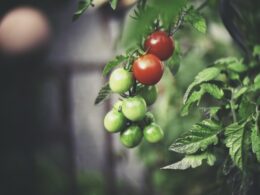Are you wondering if it’s a good idea to spray water on your tomato plants? You’re not alone! Many gardeners are concerned about the best way to hydrate their precious plants and keep them healthy. After all, tomatoes are a popular crop in home gardens because they’re not only delicious but also packed with nutrients. Providing your plants with the proper care is essential for ensuring a bountiful harvest.
In this article, we’ll explore the pros and cons of spraying water on tomato plants, along with alternative watering methods that might be better suited for your gardening needs. We want to make sure you feel confident and safe in your approach so that you can grow some fantastic tomatoes this season!
Understanding Tomato Plant Watering Needs
It’s essential to grasp the watering needs of your beloved tomato plants for their optimal growth and health. These juicy, delicious fruits require consistent and proper watering to thrive. Understanding how much water they need and when can help you avoid common problems like cracking or diseases that result from overwatering or underwatering.
To keep your tomato plants healthy, it’s crucial to maintain an even soil moisture level. Watering consistently helps prevent fluctuations in moisture levels that can stress the plants, which might make them more susceptible to pests and diseases. Aim for a deep watering once or twice a week, depending on the weather conditions; during hot spells, you may need to water more often.
Always check the soil with your finger before watering – if it feels dry about an inch below the surface, it’s time for a drink!
So remember: consistency is key! Keep an eye on your tomato plants’ soil moisture levels and adjust your watering schedule as needed based on weather conditions and plant growth stages.
By giving them just enough water at the right times, you’ll be rewarded with strong, healthy tomato plants that produce plenty of tasty fruit for you to enjoy safely throughout the season.
Happy gardening!
Pros of Spraying Water on Tomato Plants
There are several advantages to misting your tomato plants with water, enhancing their overall health and growth.
For starters, spraying water on the leaves can help reduce the risk of pests and diseases. Many common tomato plant issues, such as spider mites and powdery mildew, thrive in dry conditions. By maintaining a moist environment on the leaves’ surface, you’re creating an inhospitable environment for these pesky problems.
Another benefit of misting your tomato plants is that it can help keep them cool during hot summer days. When temperatures rise, plants can become stressed and struggle to take up water efficiently through their roots. By providing a light mist on the foliage, you’re helping them cool down through a process called transpiration – similar to how we humans sweat to regulate our body temperature. This cooling effect will make your tomato plants more comfortable and better able to grow strong and healthy.
Misting your tomato plants doesn’t just benefit their health; it also helps increase pollination rates by attracting pollinators like bees and butterflies that need water for survival. As these beneficial insects visit your moistened flowers in search of hydration, they’ll inadvertently transfer pollen from one blossom to another – leading to higher fruit production in your garden!
So, go ahead and give those tomatoes a gentle spray now and then; not only will it contribute positively to their well-being but also boost your harvest yield at the end of the season.
Cons of Spraying Water on Tomato Plants
Before you start spraying water on your tomato plants, consider the potential downsides. Spraying can create a damp environment that promotes the growth of harmful pathogens and fungi. This, in turn, can increase the risk of disease and fungal infections. Moreover, this method isn’t the most efficient way to deliver water to your plants’ roots. As a result, it could lead to wasted resources.
Additionally, adjust the paragraph structure in the Input to logically group complete sentences on their own lines, with a double new line after. Don’t forget to use contractions.
Risk of Disease and Fungal Infections
Beware, dousing those juicy red gems with H2O might just invite unwanted guests like diseases and fungal infections! While it’s true that tomato plants need water to grow strong and produce tasty fruits, spraying the leaves and stems with water can create a perfect environment for pathogens to thrive.
Damp conditions are a breeding ground for fungi, bacteria, and viruses that can wreak havoc on your precious tomato crop. To keep your tomatoes safe from these harmful invaders, be sure to water them at the base of the plant rather than overhead. By doing so, you’ll help maintain a dry environment around the foliage which discourages disease development.
And don’t forget: prevention is key when it comes to keeping your garden healthy and fruitful. So stay vigilant in your watering habits – those plump red beauties will thank you for it!
Inefficient Water Usage
Be mindful that dousing your precious tomatoes from above can also lead to inefficient water usage, which isn’t ideal for the environment or your wallet.
When you spray water on tomato plants, a significant amount of it will evaporate before reaching the roots or simply miss the target altogether. This means you’ll need to use more water to ensure your plants get the hydration they need, and as a result, you may end up with higher utility bills.
Instead of spraying water over your tomato plants, consider using a more efficient watering method like drip irrigation or soaker hoses. These systems deliver water directly to the soil around your plants’ roots, ensuring they receive sufficient moisture while using far less water overall.
By making this simple change in how you care for your garden, you’ll not only save money but also help conserve our planet’s most precious resource – all while keeping your beloved tomato plants safe and healthy.
Alternative Watering Methods
There are several alternative methods for watering your tomatoes, each with their own benefits and drawbacks. One popular method is using a drip irrigation system, which delivers water directly to the base of your plants through tubing and emitters. This method conserves water by reducing evaporation and runoff, while also providing consistent moisture to your plant’s roots.
Another option is to use a soaker hose, which releases water slowly along its length, allowing it to seep into the soil around your tomatoes. When choosing between these methods, consider factors such as cost, installation time, and ease of use.
Drip irrigation systems can be more expensive upfront but provide precise control over how much water each plant receives. Soaker hoses are generally cheaper and easier to install but may require more maintenance as they can sometimes become clogged or damaged. Both methods help prevent common issues like fungal diseases and overwatering by delivering water directly where it’s needed most.
Experimenting with different watering techniques can help you find the best solution for keeping your tomato plants healthy while conserving valuable resources like water. By exploring alternative methods such as drip irrigation or soaker hoses, you’re not only protecting the environment but also ensuring that your garden thrives throughout the growing season – all while giving yourself peace of mind knowing you’ve made a responsible choice in caring for your plants.
Tips for Proper Tomato Plant Watering
Now that you’ve explored alternative watering methods, let’s dive into some tips for proper tomato plant watering.
Keeping an eye on soil moisture and adjusting your watering schedule based on weather and the growth stage of your plants are key factors to consider.
Follow along as we discuss these essential tips to ensure your tomato plants thrive!
Monitoring Soil Moisture
Keep a close eye on your soil’s moisture levels to ensure those juicy tomatoes thrive! Monitoring the moisture in the soil is crucial for maintaining healthy tomato plants and preventing issues like overwatering or underwatering. It’s essential to strike the right balance, as too much water can lead to root rot and other diseases, while too little water can cause wilting and poor fruit development.
To monitor your soil’s moisture effectively, follow these three simple steps:
-
Use your finger: Stick your index finger about an inch into the soil near the base of the plant. If it feels dry at that depth, it’s time to water.
-
Invest in a moisture meter: These handy tools measure the moisture level in your soil and provide a more accurate reading than just using your finger.
-
Observe plant behavior: Keep an eye on how your tomato plants are reacting throughout the day. If they’re wilting during hot afternoons but recovering by evening, they may need more water.
By staying vigilant with monitoring soil moisture, you’ll be able to provide a safe environment for your tomato plants to grow strong and produce delicious fruits!
Adjusting Watering Schedule Based on Weather and Plant Growth Stage
Don’t let unpredictable weather ruin your precious crop. Adjust your watering schedule according to the climate and your tomatoes’ growth stage to ensure a bountiful harvest. Keep an eye on the weather forecast and be prepared to change up your watering routine when needed.
For example, if it’s been hot and dry for a few days, you may need to water more frequently. Conversely, if there’s been a lot of rain or cooler temperatures, you can scale back on watering.
During different stages of their growth, tomato plants have varying water needs. When they’re small seedlings, make sure the soil stays consistently moist but not soaked. As they grow larger and start producing fruit, gradually increase the amount of water you provide. This will help prevent common issues like cracking or blossom end rot.
Remember that consistency is crucial. Sudden changes in watering habits can stress out your plants and harm their growth. By staying vigilant about both weather conditions and plant needs, you’ll keep those tasty tomatoes safe and thriving!
Conclusion
In conclusion, spraying water on your tomato plants isn’t always the best method. There are pros and cons to this approach, and you’ll need to weigh them carefully before deciding what’s right for your garden.
Remember that proper watering is crucial for healthy tomatoes. Stick with alternative methods like drip irrigation or soaker hoses if possible, and follow our tips to ensure your plants stay happy and hydrated.









